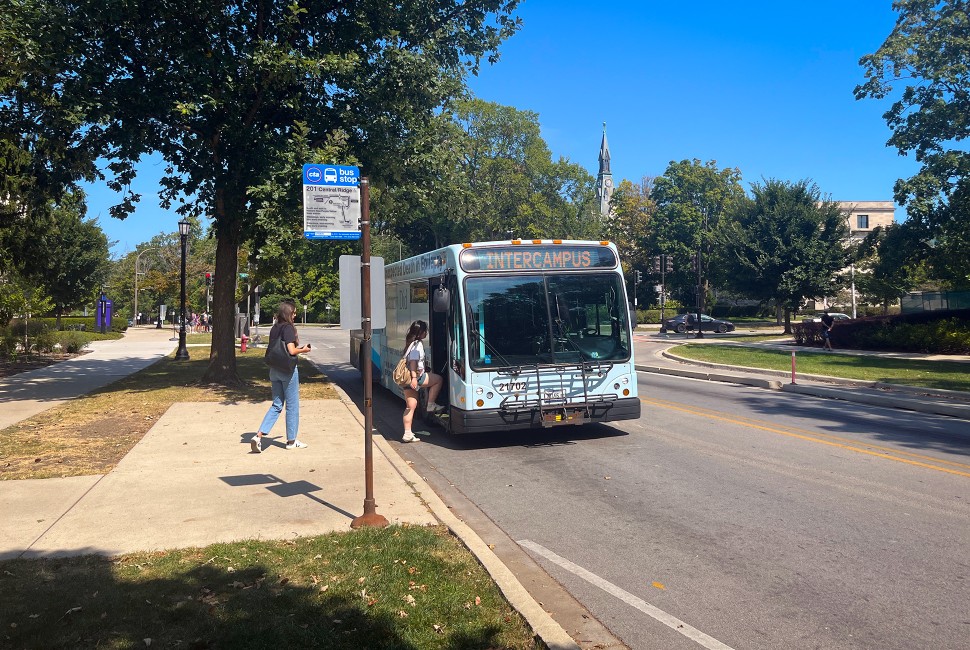Traveling to, from and around campus will be a little easier this fall thanks to some improvements to Northwestern’s transportation system.
Working with its vendor WeDriveU, Northwestern analyzed recent ridership data to develop a network of offerings that includes shuttle enhancements, an improved Safe Ride experience for students and, starting next fall, a more sustainable bus fleet.
The collaborative effort took place over the past year and included contributions from Procurement and Payment Services, Transportation and Parking, Student Affairs and sustainNU.
“When it comes to serving the transit needs of the entire Northwestern community, it’s not a one-size-fits-all approach,” said Merrill Silverman, director of Transportation and Parking. “We’re trying to provide a mix of choices and services that is safe, convenient, easy to use and environmentally friendly.”
To help you navigate from point A to B, Northwestern Now has summarized key changes.
Better shuttle service to connect campuses and downtown Evanston
Northwestern operates several shuttle routes and stops across campus, throughout downtown Evanston, along Chicago Avenue and Sheridan Road and extending to Ryan Field. Route information for all University shuttles can be found on the Campus Shuttle Routes webpage.
The Evanston Loop and Campus Loop have been combined into one new route that flows in both directions — with more frequent stops.
Other existing routes will continue to operate unchanged, including the Frostbite and Student Gameday. The Intercampus shuttle covers some of the areas served by the CTA #201, particularly the downtown Evanston area and Ryan Field. In addition, there are a number of shuttles that serve the Chicago campus.
Northwestern is also purchasing a new fleet of hybrid-electric shuttle buses for use starting in fall 2025. Northwestern’s transition from diesel to hybrid-electric is a major step forward for sustainability on campus. The hybrid shuttles use electric energy generated by bus operations and diesel fuel when additional power is needed. This dual approach reduces CO2 greenhouse gas emissions equivalent to taking three diesel shuttles off the road.
The new buses will emit less harmful pollutants compared with their diesel predecessors and are equipped with geofencing technology that allows them to operate emissions-free in designated Zero Emission Zones, including high pedestrian traffic areas and bus depots.
To read more about Northwestern transportation, including other commuter options, service updates and a list of FAQs, visit Transportation and Parking.
NU Transit: An easier and more comprehensive app
A service provided by Via transportation to Northwestern students as a safe and free alternative to walking alone after dark, Safe Ride will be augmented this fall with company drivers in company-owned vehicles, hybrid cars and ADA-accessible vehicles. A new integrated app, called NU Transit, will be launched this fall, which enables students to see options for Safe Ride vehicles and shuttle buses in real-time all on one screen.
The Safe Ride service is available from 7 p.m. to 3 a.m., seven days a week during the academic year when classes are in session. The NU Transit app can be downloaded from the Apple and Google Play stores by searching for “NU Transit.” Students who currently have the Safe Ride app will not need to download the new version. Students can login using their Northwestern NetID and password. Students who do not have a smartphone can call 224-267-9842 for reservations.
“By integrating real-time tracking for Safe Ride vehicles and shuttles into a single app, we’re leveraging technology to ensure students have quick, reliable transportation options at their fingertips,” said Jeremy Schenk, associate vice president of operations and services in Student Affairs. “The NU Transit app, as well as updates to Safe Ride and our shuttles are designed to make getting around campus even easier and more secure for students.”
Safe Ride is offered as a safety service option and is not meant to serve as a taxi or rideshare. For more information, including answers to frequently asked questions, visit the Safe Ride website.


